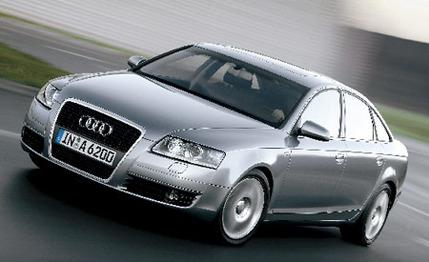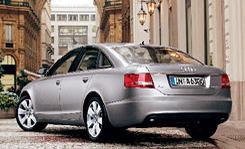
 First Drive Review
First Drive Review
Car companies, like sharks, must keep swimming or perish. Audi is really churning the waters these days. Volkswagen's platinum-Visa division is fixing to chuck much of the industrial Bauhaus styling introduced with the TT, stick a daringly oversize schnoz on all its cars, ratchet up the line's handling standards to BMW levels and beyond, and take race-developed fuel-injection technology into the mainstream.
All that backstroking culminates when the car you see pictured here, the redesigned Audi A6, arrives at dealerships later this year. Mind you, not in U.S. showrooms, which won't get their first V-6- and V-8-powered Quattros until November 2004, but in stores in Germany and Mainland China. Combined, those markets are expected to take 31 percent and 25 percent, respectively, of the yearly 180,000-unit A6 build (the States will order a lowly 15 percent). If China is happy, Audi is happy.
Such a heavy burden for the new A6, but then Audi has decided that its mid-size, or "C" class, car should use its higher volume to lead the way with the company's new styling and gizmos. What you see here, in other words, you're gonna get in one form or another in every Audi.
Let's start with the, uh, obvious. Cyrano de Bergerac might have asked, "Was this the nose that launched a thousand ships and burned the topless towers of Ilium?" No, but the so-called Nuvolari grille may launch Audi's sales into orbit--or, possibly, incinerate them. For certain, it won't be mistaken for anybody else's idea, says A6 exterior designer Achim Badstübner.
"In my opinion, we needed to make a very strong statement. BMW has its kidneys; Mercedes has its own grille shape. We wanted much more emotion in the A6, and the key was the front end."
The grille, also introduced this year on the W-12 A8, was only one of many radical ideas kicked around the design studio. Audi has decided that its much-copied Bauhaus theme--the sharp, straight creases, perfect radiuses, and machined metal trim--"is too cold," says Badstübner. "In the '90s, it was a very rational design for a rational period. But things are more emotional now, and you have to go with the times. What we're missing is the human link."


Outside, that means upturned swooshes along the door bottoms, compound curves in the hood, and a slight taper to the tail. The decklid spoiler "isn't needed for aero, it just makes the car look more self-confident," says Badstübner. What's more modern than a self-confident car? Inside, the warm-up continues with real burled wood (an option), squishy slush-molded dash and door-panel skins, and large teardrop-shaped gauges. This is a kinder, gentler Audi.
The new A6 is bigger, notably with 3.3 more inches in the wheelbase. Most of that growth, or 2.4 inches, comes from moving the front axle forward relative to the dashboard. That changes the distribution of weight--up overall about 90 to 130 pounds, depending on the engine. It's a better split of the A6's claimed 3700 pounds (with a V-6) to 3850 pounds (with a V-8) for handling, says Georg Middelhauve, the manager of steering development.
Middelhauve jumped from BMW five years ago to help make the blue-and-white spinner's handling magic work for Audi. The new A6 uses a version of Audi's familiar four-link front suspension and trapezoidal-link rear, but new aluminum wheel hubs at all four corners cut unsprung mass. More important to the A6's steering-wheel feel, says Middelhauve, are the details you can't see.
"If you don't concentrate on friction very hard, you have a disadvantage," he says. A pair of Middelhauve's engineers did nothing but work on ball-joint designs--the A6's intricate front end has 10 of them--for two years. The company developed new grease that reduces ball-joint friction and improves durability. Middelhauve also fought and won a battle to yank the vulcanized rubber isolators, used in Audis for years to help dampen minor road impacts, out of the tie rods.
"Why have this rubber link when a direct link is better?" he asks.
A 335-hp DOHC 40-valve 4.2-liter V-8 and standard six-speed automatic are hand-me-downs from the A8. The news resides with the new 255-hp DOHC 24-valve 3.1-liter V-6. The engine injects gasoline directly into its high-compression (12.5:1) cylinders via a camshaft-driven pump making pressures up to 1450 psi. The engine enjoys millisecond-precise injection timing and works in conjunction with air-tumbling flaps in the intake to improve air-fuel mixing. Up to 10 percent more power and four to five percent better fuel economy result from the timelier and more thorough explosions, Audi says. It should know; Audi won Le Mans three times using the same technology to blow past its competitors.
Does the new A6 blow past its competitors? Maybe. Audi unfathomably decided to introduce the car in Milan, Italy, where the relentless traffic capped our speeds at about 40 mph. We know this: The V-6 Quattro automatic (sorry, no manuals yet) should start at about $45,000, the V-8 Quattro at about $50,000, when prices are set later this year. A front-drive V-6 with a continuously variable transmission will debut much later, likely in 2006, about when the RS 6 appears with a rumored 500-horsepower V-10.
By then, the A6's big honker will be no big deal.